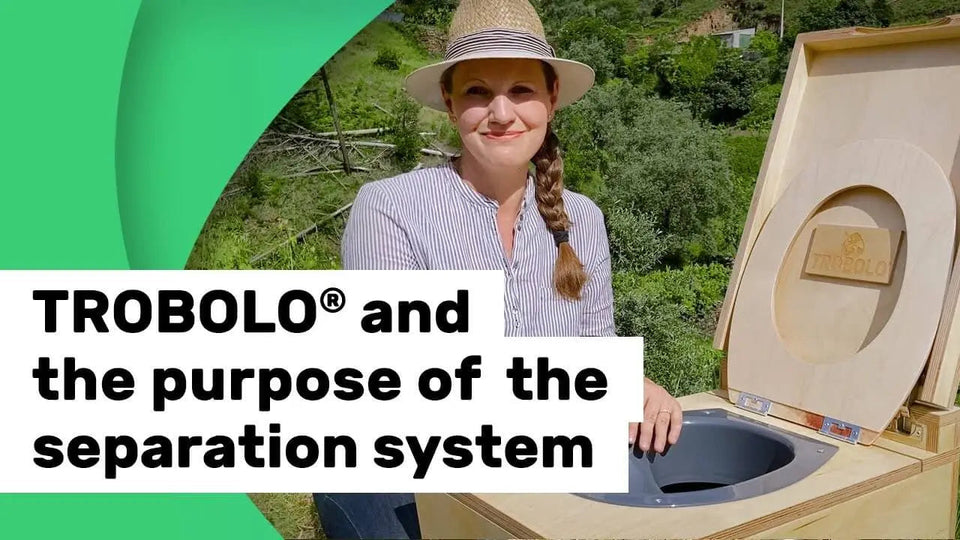
FREQUENTLY ASKED QUESTIONS
We look forward to answering your open questions
Here you will find short and clear answers to frequently asked questions.
Functionality & separation system
Functionality & separation system
How do I use a TROBOLO?
Using a TROBOLO differs little from using a conventional toilet. The sitting position is identical to that of a regular toilet – this applies to both men and women. Thanks to the contact-free separation system the body only touches the toilet seat. Merely urinating while standing should be avoided as the urine cannot be fully separated in this case.
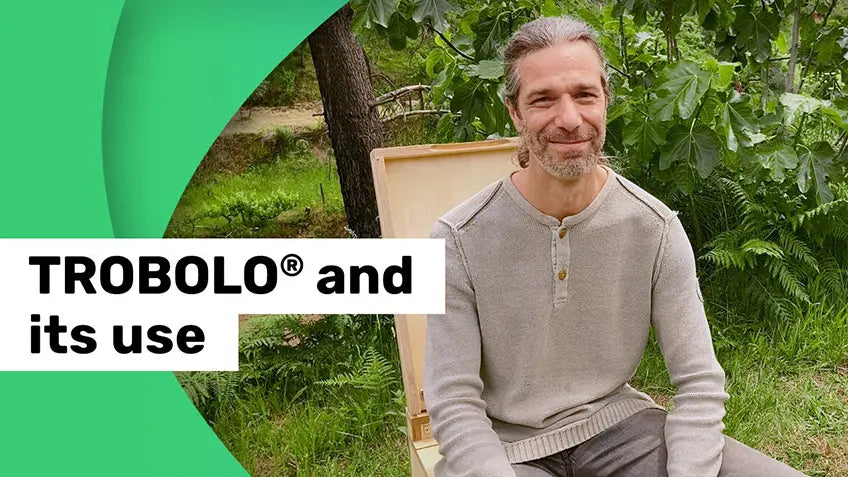
How does a composting toilet work?
Composting toilets are self-contained systems that don’t require water, electricity, or chemicals. They include one or more containers inside to capture all waste. Basic composting toilets gather both urine and solid waste in one single container. Those with a separation mechanism use two containers and have an insert that directs urine into a liquids container, while solids go into a separate solids container. Collecting liquid and solid toilet waste in separate containers facilitates waste disposal enormously, while simultaneously reducing odours to a minimum. The whole process is absolutely hygienic and at no point do you come in touch with excreta. Since no connection to the sewage system or electricity network is needed, a composting toilet can be used self-sufficiently at any location.
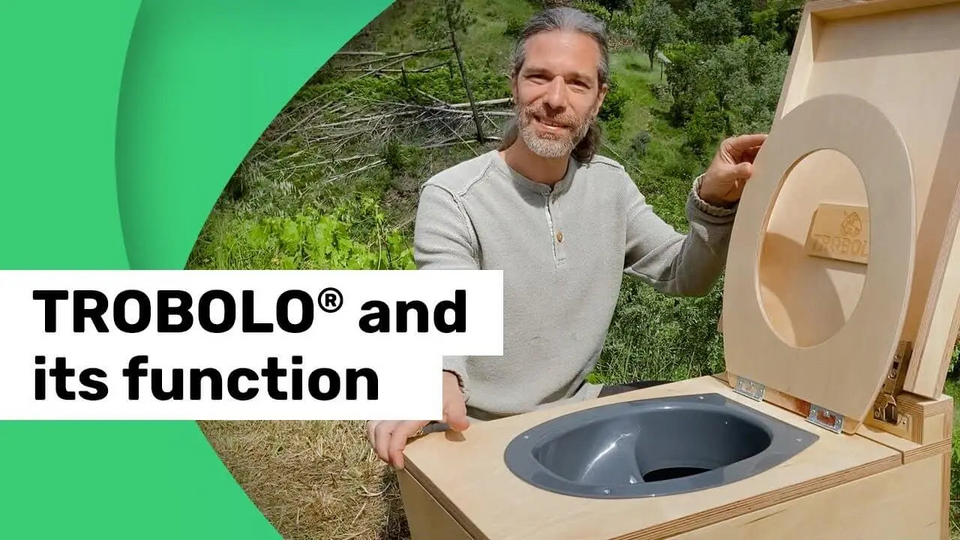
How does the seperation system work?
The separation is made possible by an integrated urine diverter made of durable plastic. This urine diverter directs the urine via the front part of the toilet opening into the liquids container or into an external tank. The solid faeces and toilet paper end up in the container for solids via the rear of the toilet opening. The separation system is adapted to the human anatomy so that any physical contact is avoided.
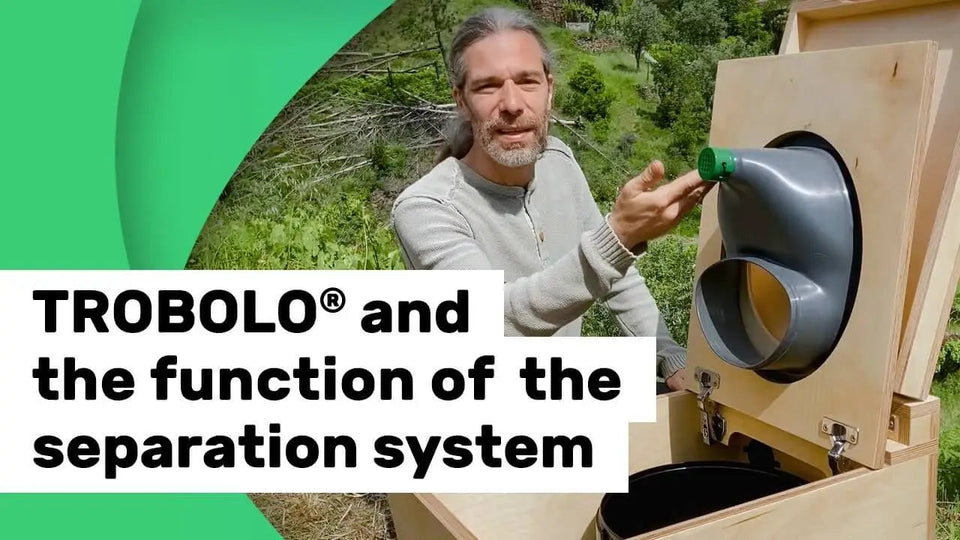
What is the function of the seperation system?
Exhaust system & litter
Exhaust system & litter
How does the electric exhaust system work?
The electric exhaust system permanently generates a slight vacuum and thereby directs moisture and remaining odours outside via an exhaust air pipe. It can be flexibly connected via USB connection (12V, 24V or 230V) and has an extremely low power consumption, which equates to an annual power consumption of less than 6 euros at a continuous use. The max. current is 0.26 A, the max. power consumption 1.3 W and the noise level 19.3 dB. The additional use of litter is not required.
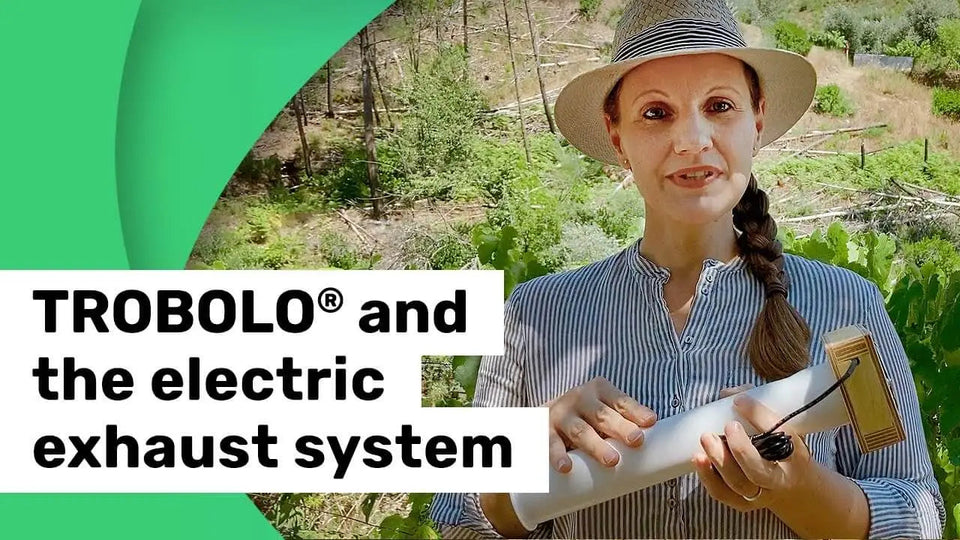
How does the natural exhaust system function?
The natural exhaust system makes use of the chimney effect. Due to this natural effect the warm air rises and is extracted outwards via an exhaust duct. That way, moisture and remaining odours are led out of the toilet and as a consequence unpleasant odours are neutralized. No electrical energy is needed for this.
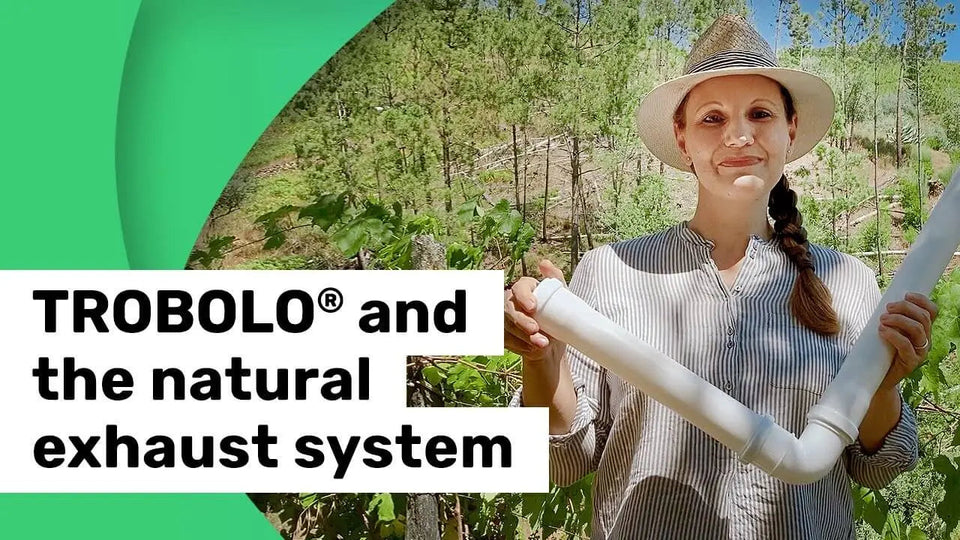
What is litter?
Litter consists of compostable and absorbent materials such as wood shavings. With the help of a small container, approximately 250ml of litter is placed in the back of the toilet opening after every defecation, where it covers the faeces and the used toilet paper and absorbs moisture and any remaining odours. The litter is only necessary with TROBOLO composting toilets that do not have an electrical exhaust system.
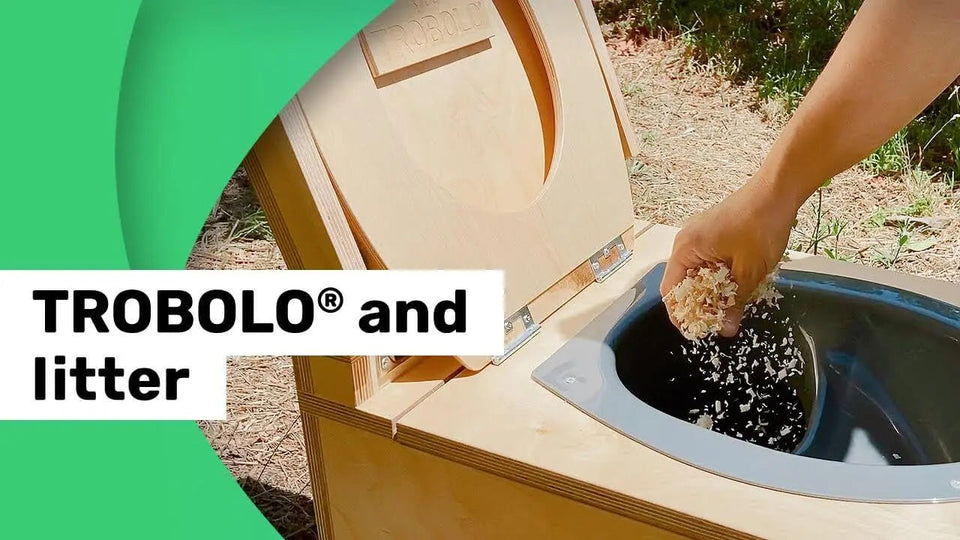
Can sawdust or wood chips produced at home be used in place of the litter?
If you happen to have wood waste products like sawdust at home due to DIY projects, you can simply use these as an alternative to the litter or add them to your existing TROBOLO litter. You should only make sure that the sawdust is neither too fine nor too coarse. For this, you can use the consistency of our TROBOLO litter as a guide.
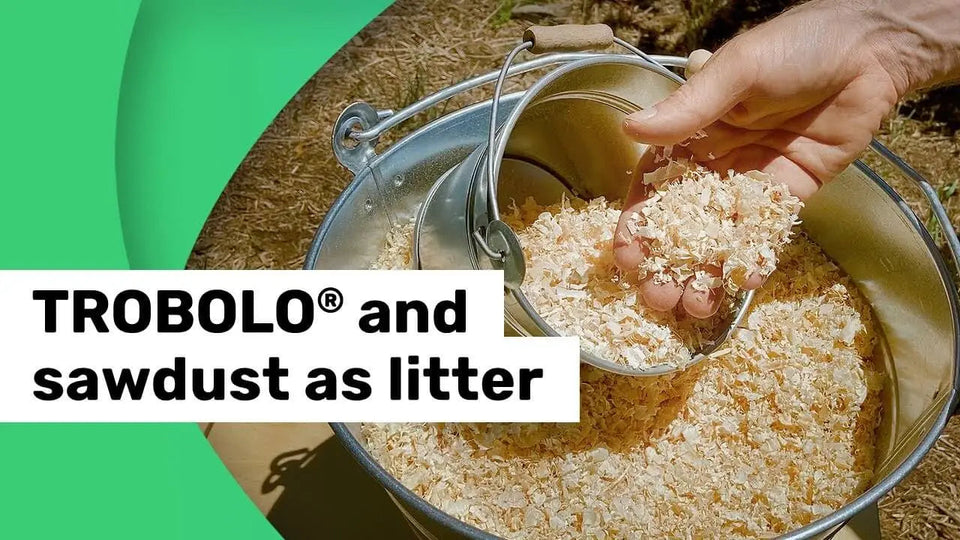
Toilet Paper
Toilet Paper
Can you flush toilet paper in a composting toilet?
Since a composting toilet doesn’t use any water, flushing isn’t involved. However, this doesn’t necessarily mean you can’t dispose of toilet paper in it. With TROBOLO composting toilets, you can simply put your toilet paper in the solids container, located in the back part of the toilet, similar to where you would place it in a traditional toilet. If you choose to compost your toilet waste, ensure you use compostable toilet paper without any chemical additives. Please be aware that while all TROBOLO composting toilets can handle toilet paper perfectly fine, other models, especially those with stirring mechanisms, might not be suitable for this.
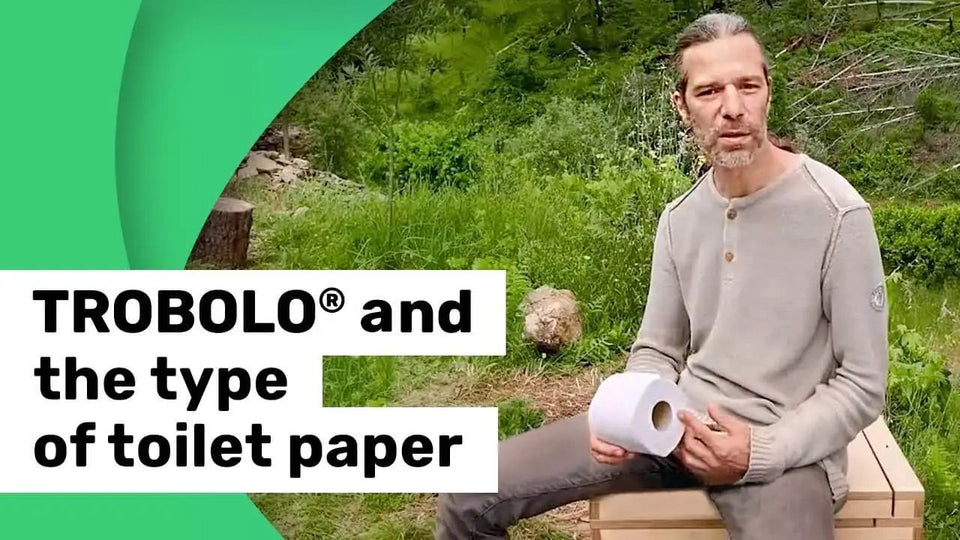
Emptying
Emptying
How do I empty my TROBOLO?
All TROBOLO models can be easily opened from the top to remove the two separate containers inside. To do this, the TROBOLO is first opened, then the containers are closed with the accompanying latches by simply pressing or screwing them on. The last step is to remove the containers to transport them to the emptying location.
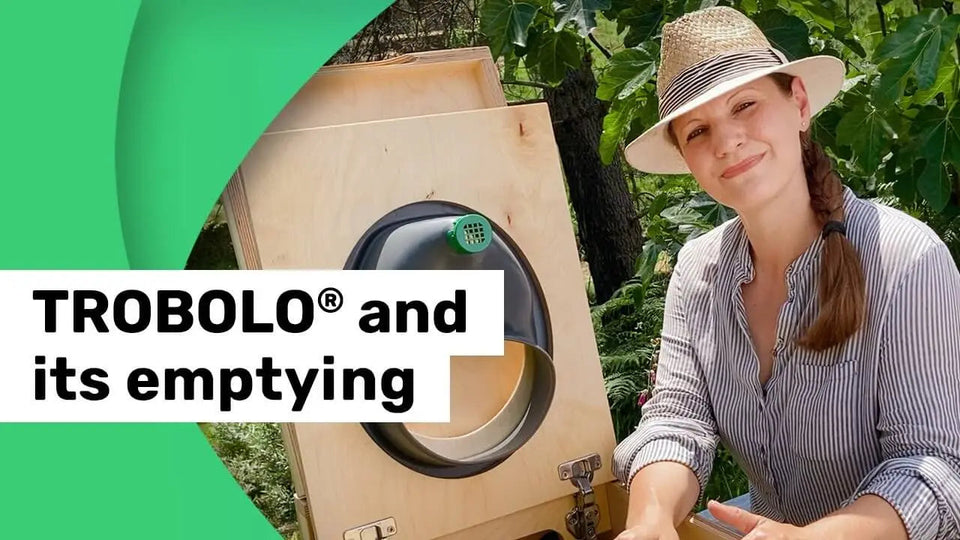
Where do you empty a composting toilet?
Regarding emptying your composting toilet, you have several options. You can dispose of the solid waste by tossing it in with your household trash or composting it. Simply remove the inlay with the waste from the solids container and toss it into your household trash, similar to how you would dispose of a used diaper. Alternatively, if you prefer composting, place the inlay and its contents in your composter. Just make sure to use our compostable inlays for this option. As for the liquid waste, you can flush it down a regular toilet or dilute it with water and use it as natural fertiliser for your ornamental plants.
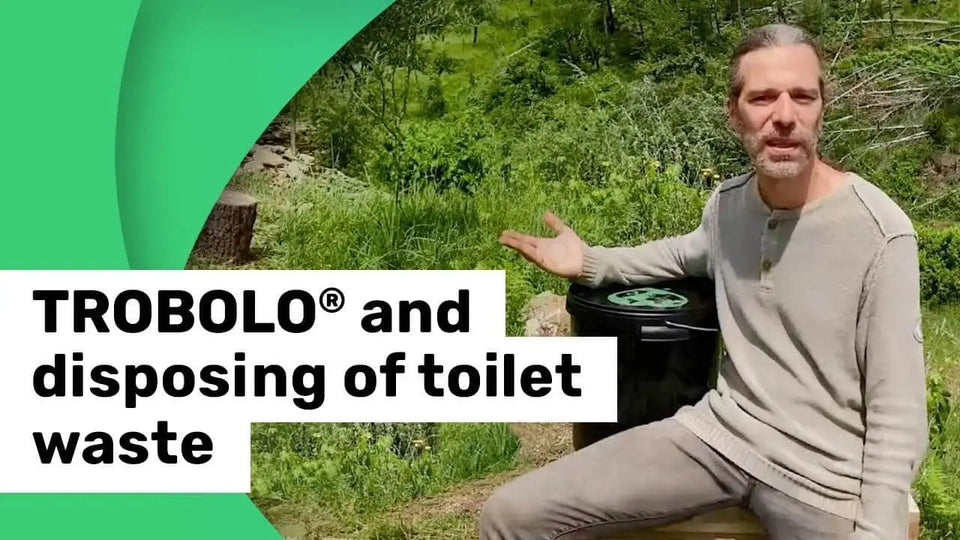
Composting
Composting
Do I need a special composter?
For the correct composting of toilet waste, it is recommended to use a closed composter. This prevents unpleasant odours during the composting process and the intrusion of excessive rainwater, which turns into black water when it comes into contact with not yet composted material and should not seep away into the ground. Commercially available hot composters usually fulfil these requirements. You can also find composters specially designed for this purpose in our online shop.
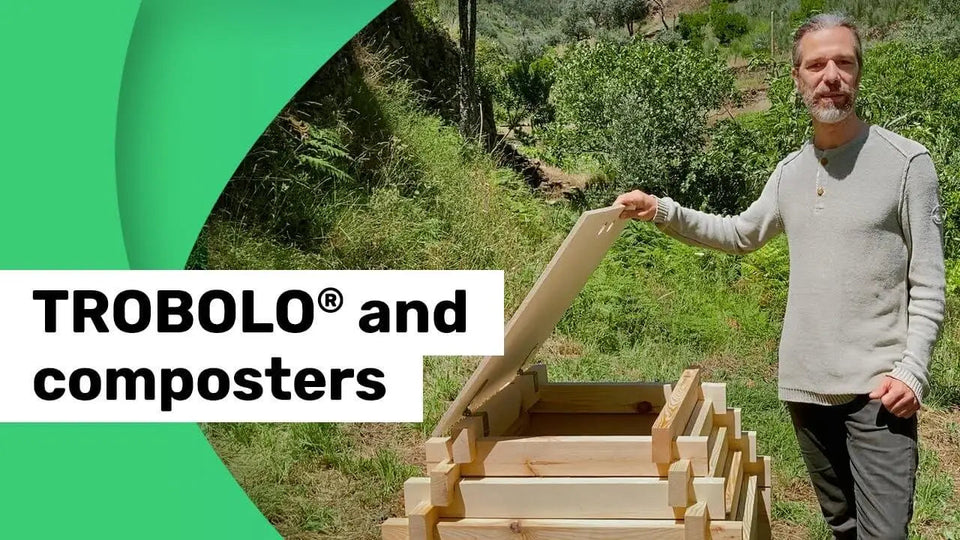
What can I use the composted toilet waste for?
During the composting of toilet waste, these quickly lose their volume and can no longer be recognised as such within a few weeks. To make sure that all substances that might possibly be unhygienic are eliminated, a composting period over 24 months is recommended. The finished humus can be used in your garden as organic fertiliser for ornamental flowerbeds.
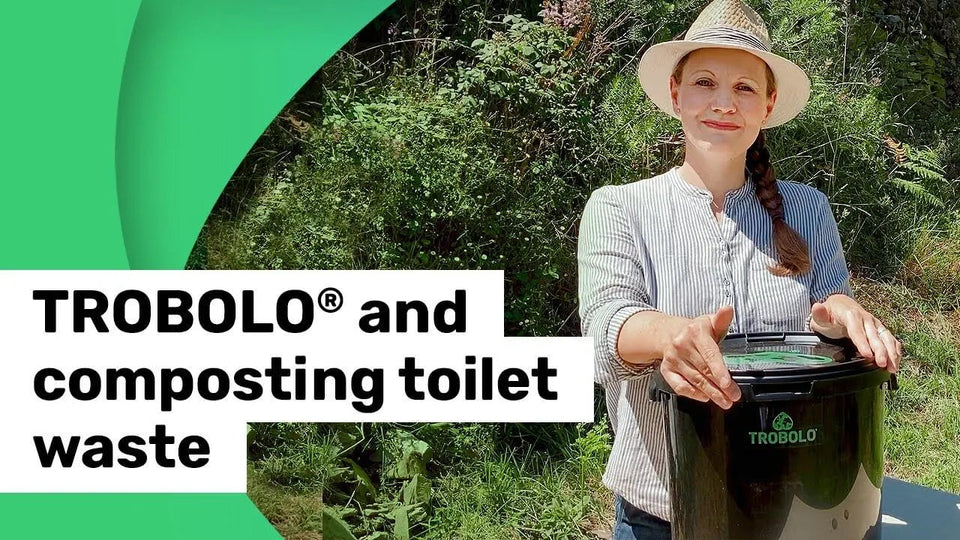
Hygiene & cleaning
Hygiene & cleaning
Do composting toilets smell?
Composting toilets are well-known for their odour-free operation. However, keeping them that way requires regular maintenance. Unpleasant smells usually happen when feces and urine mix and start to break down. It’s best to use a composting toilet with a urine diverter to avoid this issue. By separating solid and liquid waste, you prevent odour from forming right from the start, slowing down the process of smell development. Extra steps can be taken to completely avoid bad odours. For example, putting a bit of litter on top of the solid waste helps keep the container odour-free for extended periods.
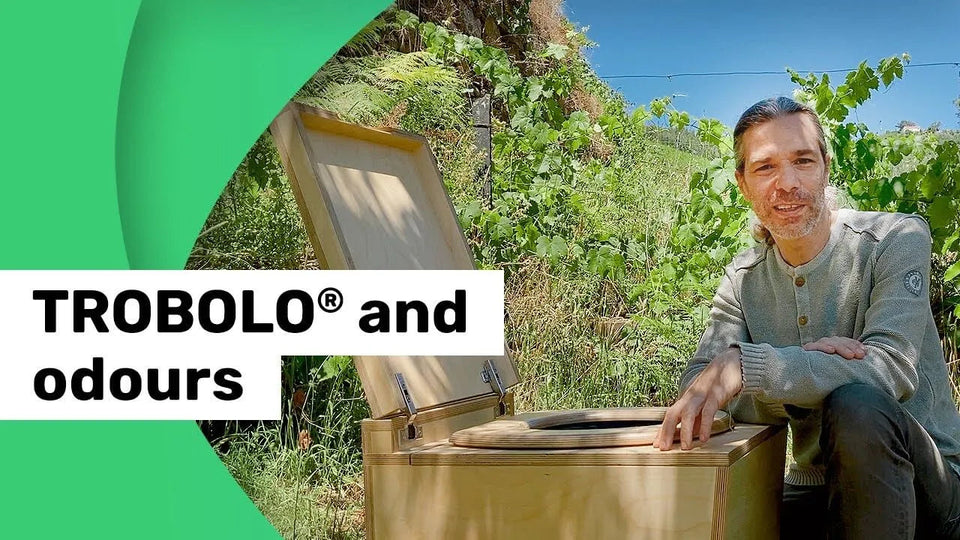
Is a composting toilet gross?
Composting toilets are not considered gross because since are odorless, hygienic, and easy to clean. You never come in direct contact with the waste, and because solid and liquid waste are kept separate, the emptying process is much cleaner compared to chemical toilets or dry toilets without a urine diverter. Additionally, as there is no water involved, you never face issues such as clogging, leaking, or overflowing.
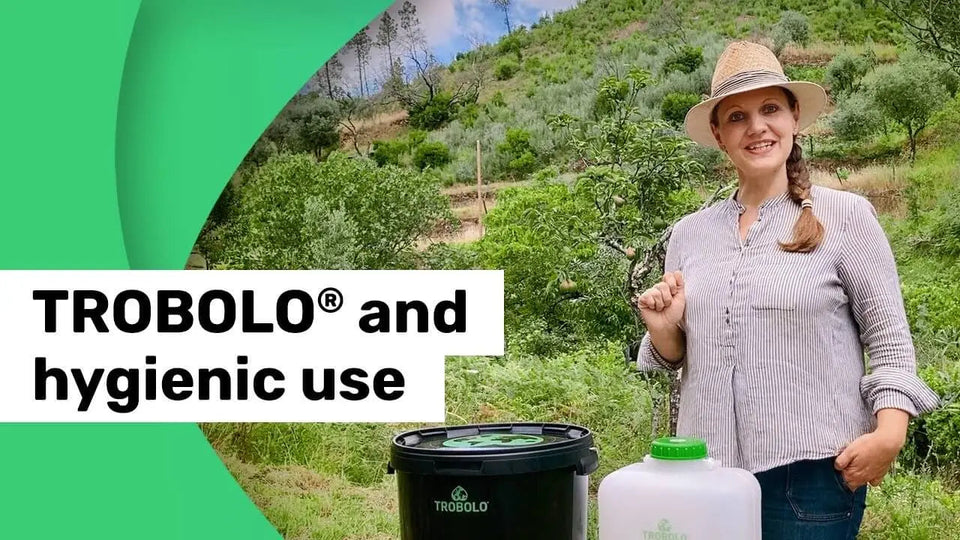
How do I clean my TROBOLO?
The cleaning effort for our composting toilets is generally less than for a conventional toilet. For example, you don’t even need a toilet brush, as the solid waste falls directly into the solids container provided, which is positioned below the large opening of the divider. Even if you suffer from diarrhoea, the waste only comes into contact with the replaceable inlay in the container, protecting it from contamination.
The urine container also does not require any elaborate cleaning procedure. You simply wash it out after each emptying with a little warm water and at best a dash of vinegar or biological cleaner – et voilà.
If the body of your TROBOLO also needs cleaning, you can do this with confidence. The surfaces of our wooden models are impregnated with a natural oil and can be cleaned with a damp cloth, just like the wooden toilet seat, which is sealed with an antibacterial protective coating. The body of the TROBOLO WandaGO can be cleaned in all corners and ends, as you like without hesitation, because it is made of polypropylene.
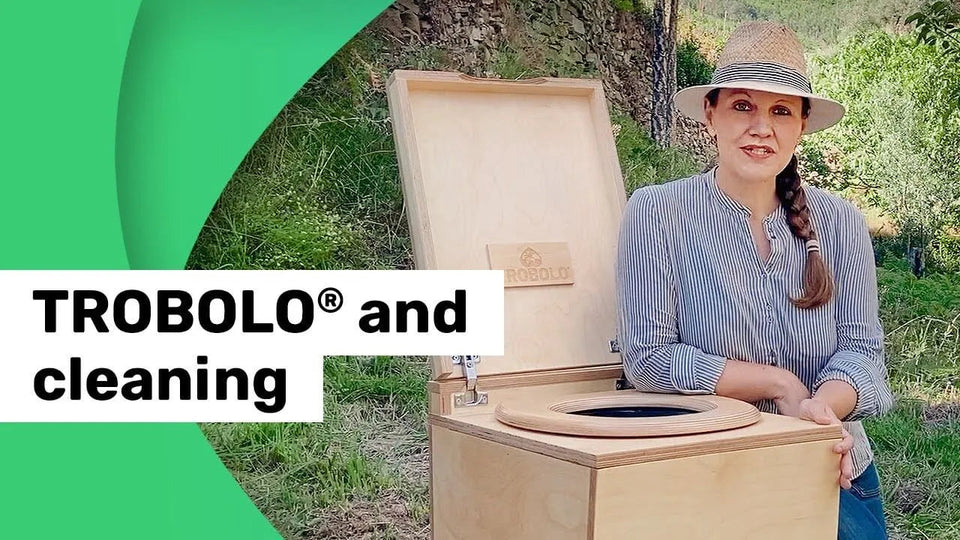
Do I have to clean the containers?
After each emptying, the solids container is fitted with a new inlay, which is inserted into the container similar to a bag. This prevents contamination and thus time-consuming cleaning.
The liquids container should be rinsed out after each emptying with warm water and a dash of vinegar, lemon cleaner or – at best ecological – detergent. If you also pour a dash of vinegar into the container every now and then, this not only neutralises odours but also prevents urine particles from sticking to the walls of the container. Consequently, time-consuming cleaning is not necessary here either.
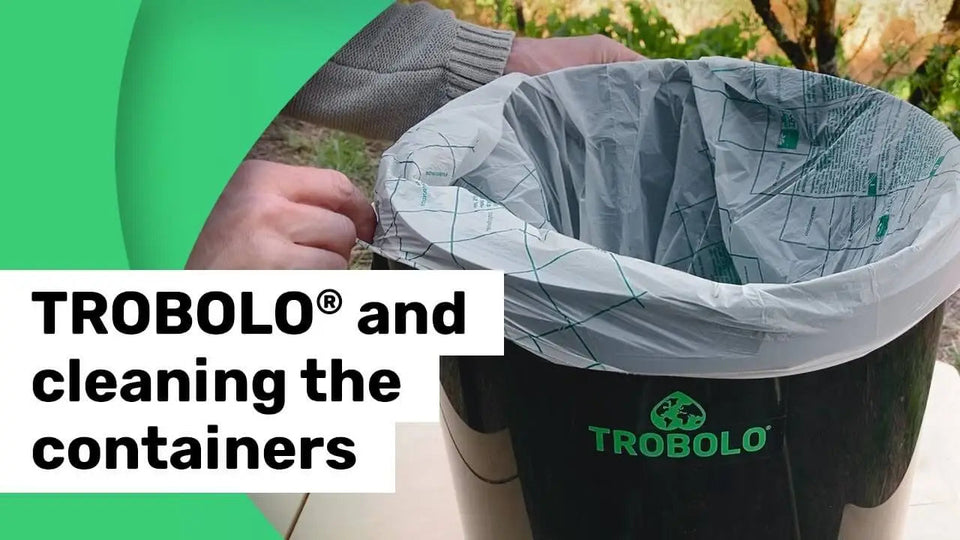
What is the TROBOLO SafeShell System®?
Our unique and patented TROBOLO SafeShell System® is designed to keep your liquids container completely odour-free at all times. This groundbreaking feature allows you to empty the liquids container at your convenience without adhering to strict emptying schedules. Moreover, the system ensures spill protection during travel, making it an ideal solution for using your TROBOLO in campervans, RVs, or other mobile setups.
legal regulations
legal regulations
Where am I allowed to use a TROBOLO?
Due to the municipal decision-making authorities, there is no extensive uniform regulation. Regionally, chemical toilets or classic ‘outhouses’ are often prohibited; composting toilets like our TROBOLO are generally permitted.
What are the wastewater directives?
Even if every municipality has its own regulations regarding the lawful water procedures, you can happily ignore these guidelines, because our TROBOLO composting toilets do not produce leachate or black water, both of which can lead to pollution of the groundwater.
Am I allowed to use a TROBOLO in an allotment?
Many of our customers already use our TROBOLO in their allotment garden, without this circumstance leading to any conflicts. To be on the safe side, you can ask your gardening association which controls the disposal of faeces and sewage in its garden regulations and and which can give you more information about this.
Do I need a building permit for the TROBOLO outdoor models?
A building permit is generally not necessary and has not yet been required by any of our customers. You can acquire binding information and a confirmation from your local planning authority.
Further Information
Further Information
Why isn't the container for liquids larger?
The 10 litre volume in our wooden models offers the best compromise between capacity, space requirements and handling. The same applies to the 4.6 litre collection container in our TROBOLO WandaGO.
At first glance, it may seem more convenient to use a larger container to extend the service life. But experience has shown that this would only bring a number of other obstacles.
After all, emptying a larger container also entails a greater weight burden. Which not everyone may be able to take on. In addition, a larger container would not fit in our models, which would mean either a complicated installation of the container outside the body of the composting toilet or building a larger body, which in turn would be difficult to stow away.
Where can I set up a TROBOLO?
Technically, anywhere. Depending on the place of installation, there are different TROBOLO models for indoor and outdoor use, e.g. for gardens, houses and tiny houses, campers and vans, and institutions. A TROBOLO works completely self-sufficient and offers high comfort even in very remote locations.
Do I need a power connection for my TROBOLO?
If you decide for a TROBOLO with electric exhaust system, you will need a power source. If no power connection is available, you can use a power bank or a solar module for self-sufficient use. Models without an electric exhaust system do not need any electricity at all.
Do ongoing expenses arise by using a TROBOLO?
The ongoing expenses are limited exclusively to the use of inlays and litter. The latter is not needed for TROBOLO models with an electric exhaust system. Instead, electricity costs arise which amount to less than 6 euros per year.
Do I have to look at feces when opening the TROBOLO?
No. Thanks to the black solids container, the incidence of light is minimal and as the toilet paper always gets added last, there is no direct view of the feces. Thus, the view is limited to the toilet paper and if you’re using litter, which would be added after the toilet paper, you’d only be seeing this.
Does it matter if the urine isn't completely seperated?
The design of the TROBOLO system ensures that nothing can be spilt and that it still works if the urine is not separated entirely. If the urine isn’t diverted correctly by the urine diverter, it simply flows into the solids container where, in small quantities, it causes no disadvantage.
Can a composting toilet handle diarrhea?
Diarrhea is not an issue when using composting toilets. Our composting toilets are designed to effectively manage all types of toilet waste with ease, even diarrhea. With all solid waste, including diarrhea, directed into the inlay of the solids container, there’s no risk of spills or mess. Just ensure you cover it with enough litter for proper drying and odour control.
Do I have to consider anything in relation to menstruation and using a TROBOLO?
Using a TROBOLO during your menstrual period is not an issue at all. Menstruation-related stains on the surfaces can be cleaned wet, just as any other stains. Regarding disposal / composting the amounts of blood caused by menstruation are negligible. Pads and similar objects shouldn’t be thrown in the containers, if you are planning to compost.
What is the maximum body weight a TROBOLO can be used at?
In principle, a TROBOLO can also be used with a higher body weight without any problems. The tested loads of the various TROBOLO models differ and range between 180 – 220kg for the wooden models and 150kg for the TROBOLO WandaGO. You can find the exact details in the respective product description.
Can you use a composting toilet in the winter?
The TROBOLO system is basically designed for year-round operation. It is free of hoses or other mechanical parts that could be affected by frost. And the accessories, such as the containers, are also designed for use in winter temperatures.
If you use the TROBOLO KersaBœm or TROBOLO KitaBœm outdoors, we recommend painting the inside and outside with a wood protection paint. In this way, you counteract changes to the wood caused by weathering.
Unlike our wooden models, the TROBOLO WandaGO is made of 100% weatherproof material and can therefore be used outdoors all year round without hesitation.
No matter which model is used to collect the urine, it will not freeze until well below the freezing point. Nevertheless, we recommend emptying the containers more frequently at temperatures below zero degrees.
How does the spill stop work?
The spill stop prevents urine from spilling out of the liquids container during transport. This means you can use your TROBOLO safely on the road, while the spill stop acts as an effective barrier against spilling liquids. The spill stop is accurately connected to the filter screen of the urine diverter and thus integrated into the separation system of your TROBOLO.
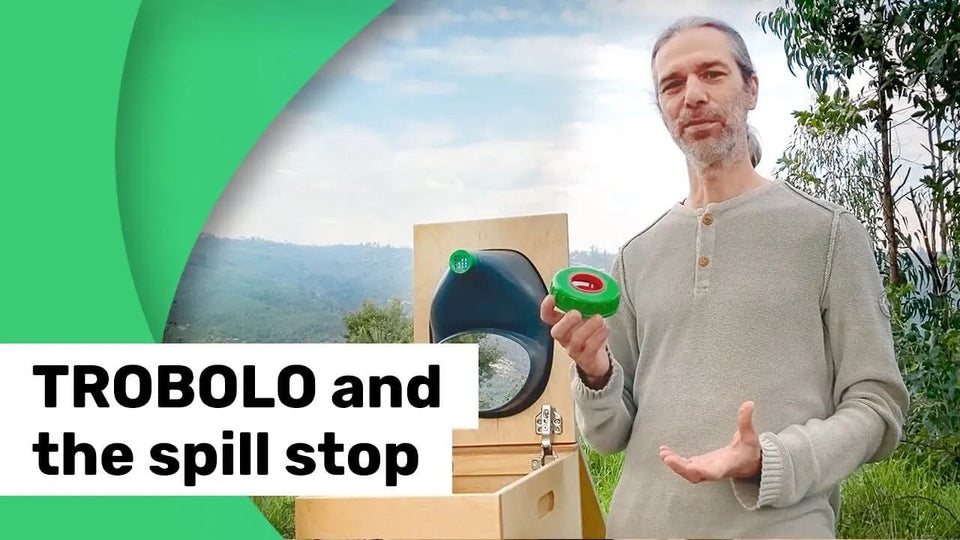
Can a TROBOLO be disassembled for mobile usage?
“For indoor and mobile use, we have developed a composting toilet apart from our all-in-one system that comes to your home as a prefabricated kit: the TROBOLO TeraBlœm. It is suitable for mobile use, for example in motor homes or even in smaller camping vans, and comes with everything you need for easy assembly.
If you prefer it even more compact and lighter, the TROBOLO WandaGO is the right choice for your mobile use. Although it cannot be dismantled, it is ultra-compact and can still be extended to a regular toilet height thanks to its stacking function.”
How do you use inlays in TROBOLO composting toilets?
To prevent the solids container of your TROBOLO composting toilet from coming into direct contact with waste, it is covered with an inlay. This allows you to easily and hygienically remove and dispose of the toilet waste including the inlay.
If you plan to compost your toilet waste, we recommend our compostable inlays made from 100% degradable corn starch. Otherwise, our recycled plastic inlays are ideal. You can dispose of them in your household waste, just like used nappies.
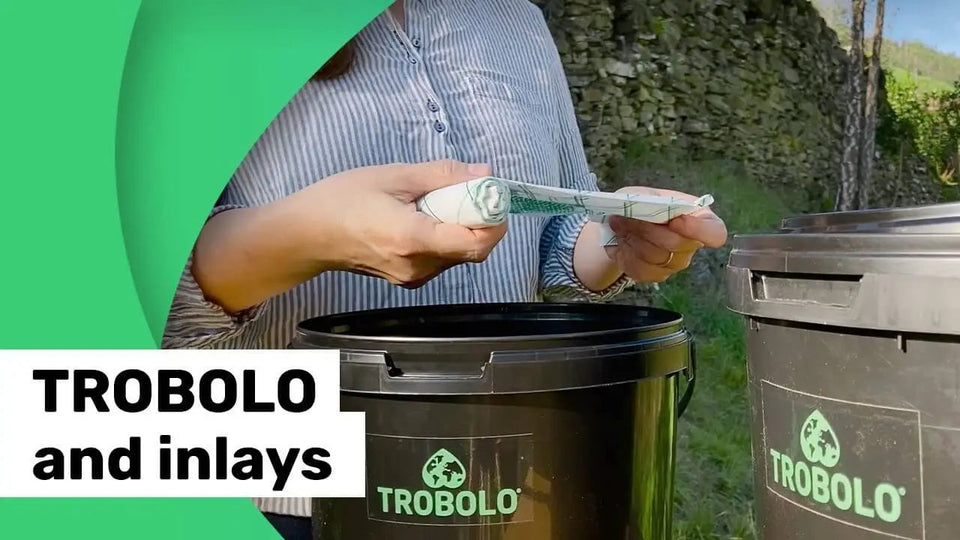
For how long can I use compostable inlays before they dissolve?
The advantage of our inlays being compostable is their composition of degradable cornstarch. However, this inevitably results in less durability which is why we recommend a weekly change of the inlay.
What material is the urine diverter of the TROBOLO composting toilets made of?
The urine diverter is made of 100% recyclable polypropylene.
Does TROBOLO offer solutions for an increased number of uses with containers that have a larger volume, such as at events for example?
Experience has shown that a larger container would involve major disadvantages when it comes to its emptying. For models with external urine drainage, for example our TROBOLO TinyBlœm, the number of uses in terms of liquid excreta depends on the size of your external tank. Alternatively, with our TROBOLO KersaBœm, it is possible to place additional interchangeable containers into the interior of the composting toilet in addition to the two solids and liquids containers that are already included in the scope of delivery. This way, either four further liquids containers or an additional solids and two extra liquids containers could then be provided. The compartment that would normally contain the litter could then be used as a storage space for these.
How robust are the roofs of the outdoor models?
A daylight roof made of polycarbonate is used. It consists of 6mm thick double-skin sheets which are weather-, hail- and scratch-resistant.
Is there a visual protection that prevents the view of feces?
We consciously avoid the installation of a visual protection in our composting toilets as this is a mechanical component that could possibly lead to faults and additional cleaning which we don’t want to burden our customers with.
For instance, a visual protection screen doesn’t function in an unobstructed way as soon as someone using the toilet sits down on it with their full body weight – which would be the prerequisite for the complete opening of the screen, and which would then inevitably lead to the soiling thereof.
What’s more, the last step in the use of ourcomposting toilets with an electric exhaust system is the addition of used toilet paper. Thus, if you look directly into the opening, you will see precisely this (the toilet paper) and not the feces of the previous user.
When using our composting toilets without an electric exhaust system, litter is also added to the used toilet paper. In this case, when looking into the opening, only the litter and possibly some toilet paper are visible as opposed to your own excretions or that of other users.
Should you have any remaining concerns about aesthetics, then adding more litter may solve this. However, we expect that this is not necessary.

Get in touch
If you have any other questions or would like detailed advice on your individual situation, please feel free to call us at 00800/55223355 or send us an e-mail at contact@trobolo.com.
